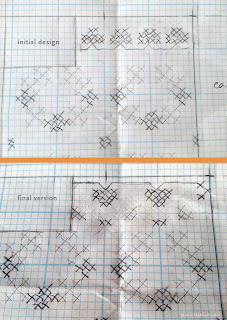Osso Buco literally means bone with a hole, i.e.—marrowbone. While a lot of Indian meat dishes feature bone-on shank pieces, the mutton and lamb that are most commonly used, are much smaller in size than the veal shank that is typical to the classic Italian osso buco, and they yield a significantly smaller bounty of the delicious treasure hidden inside the bone.
In search of that incredibly moist and unctuous marrow, I’ve whipped up multiple batches of Marcella Hazan’s Osso Buco recipe as soon as the cool, crisp days of autumn arrive. And every year, after we’ve finished sopping up the gravy and marrow with the last pieces of bread, I always plan to make an Indian-inflected version the next time.
So here it finally is—my ode to marrow.
Like Marcella’s recipe, I start the aromatics on the stovetop and finish cooking the dish in the dry, enveloping heat of the oven. It is best to cook it a day ahead and to allow the meat to luxuriate in the gravy overnight. This also allows the marrow to congeal a bit, and it is easier to dig out when the time comes.
I promise there will be no bread (or naan) left at the table!
Ingredients
Four 1½ -inch-thick slices of Veal Shank (each tied tightly around the middle with butcher twine)
¼ cup Flour (spread on a plate)
2 tbsp Vegetable oil
4 tbsp Ghee
1½ tsp whole Cumin
½ tsp whole Black Cumin (Shah Jeera)
1 tbsp whole Black Peppercorns
1 whole Black Cardamom
3-4 Bay Leaves
2 small Onions, chopped
1 tbsp crushed Garlic
1 tsp crushed Ginger
2 Tomatoes, chopped
1 tsp ground Coriander
1 tsp ground Garam Masala
2-3 tsp Chilli powder (adjust to your taste)
Salt (to taste)
½ cup plain Yogurt (whisked with 1 cup water)
8–10 whole stalks Cilantro (stems and leaves)
In search of that incredibly moist and unctuous marrow, I’ve whipped up multiple batches of Marcella Hazan’s Osso Buco recipe as soon as the cool, crisp days of autumn arrive. And every year, after we’ve finished sopping up the gravy and marrow with the last pieces of bread, I always plan to make an Indian-inflected version the next time.
So here it finally is—my ode to marrow.
Like Marcella’s recipe, I start the aromatics on the stovetop and finish cooking the dish in the dry, enveloping heat of the oven. It is best to cook it a day ahead and to allow the meat to luxuriate in the gravy overnight. This also allows the marrow to congeal a bit, and it is easier to dig out when the time comes.
I promise there will be no bread (or naan) left at the table!
Ingredients
Four 1½ -inch-thick slices of Veal Shank (each tied tightly around the middle with butcher twine)
¼ cup Flour (spread on a plate)
2 tbsp Vegetable oil
4 tbsp Ghee
1½ tsp whole Cumin
½ tsp whole Black Cumin (Shah Jeera)
1 tbsp whole Black Peppercorns
1 whole Black Cardamom
3-4 Bay Leaves
2 small Onions, chopped
1 tbsp crushed Garlic
1 tsp crushed Ginger
2 Tomatoes, chopped
1 tsp ground Coriander
1 tsp ground Garam Masala
2-3 tsp Chilli powder (adjust to your taste)
Salt (to taste)
½ cup plain Yogurt (whisked with 1 cup water)
8–10 whole stalks Cilantro (stems and leaves)
- Lightly dredge Veal in flour, turning to coat all sides, and shake off any excess flour. Heat vegetable oil in a large, heavy-bottomed pot, until smoking. Add meat and brown well on both sides. Remove veal from pot and set aside on a platter. Pour out oil and wipe pot clean.
- Heat ghee in the same pot over medium-high until smoking. Add cumin, black cumin, peppercorns, black cardamom, and bay leaves, stir for about 1 min and allow the spices to swell. Add onions and fry for 5–7 mins, until golden brown and well caramelised.
- Add garlic and ginger and continue frying for 2 mins. Add tomatoes and continue cooking for 5 mins until they disintegrate.
- Mix coriander, garam masala, and chilli powder in a little water to make into a paste and add to the pot. Stir briskly, scraping any brown bits from the bottom of the pot, until the oil starts to separate from the spice mixture, about 3-4 mins.
- Add veal and any accumulated meat juices to the pot, and stir well to coat the veal thoroughly with the spices. Add salt and yogurt, stir and bring to a brisk boil. Turn off heat.
- Add cilantro, cover the pot and place in the bottom rack of a 350ºF [175ºC] pre-heated oven. Cook for about 1½ hrs, or until the veal feels very tender when prodded with a fork, and a dense, creamy gravy has formed. Stir and baste the veal every ½ hour while it is cooking. If the liquid in the pot becomes insufficient, add 2-3 tbsps of water at a time, as needed. (Alternately, you can skip the step in the oven and continue simmering the veal on the stovetop over low heat for 1½ hrs.)
- Remove veal from oven and transfer to a warm serving platter. Gently untie the butcher twine from the veal pieces, and discard twine along with the cilantro stalks. Spoon gravy over veal and serve with warm crusty bread or naan.












